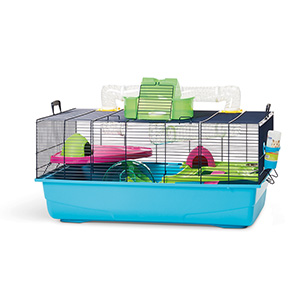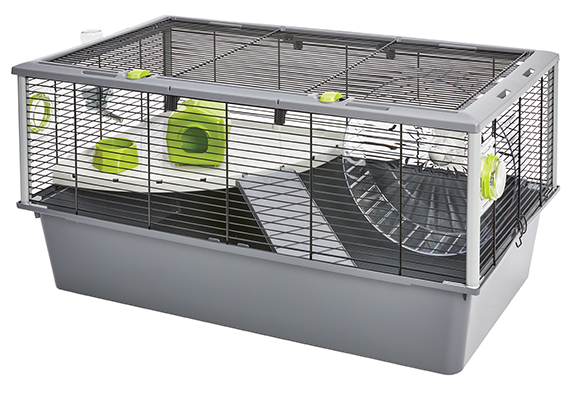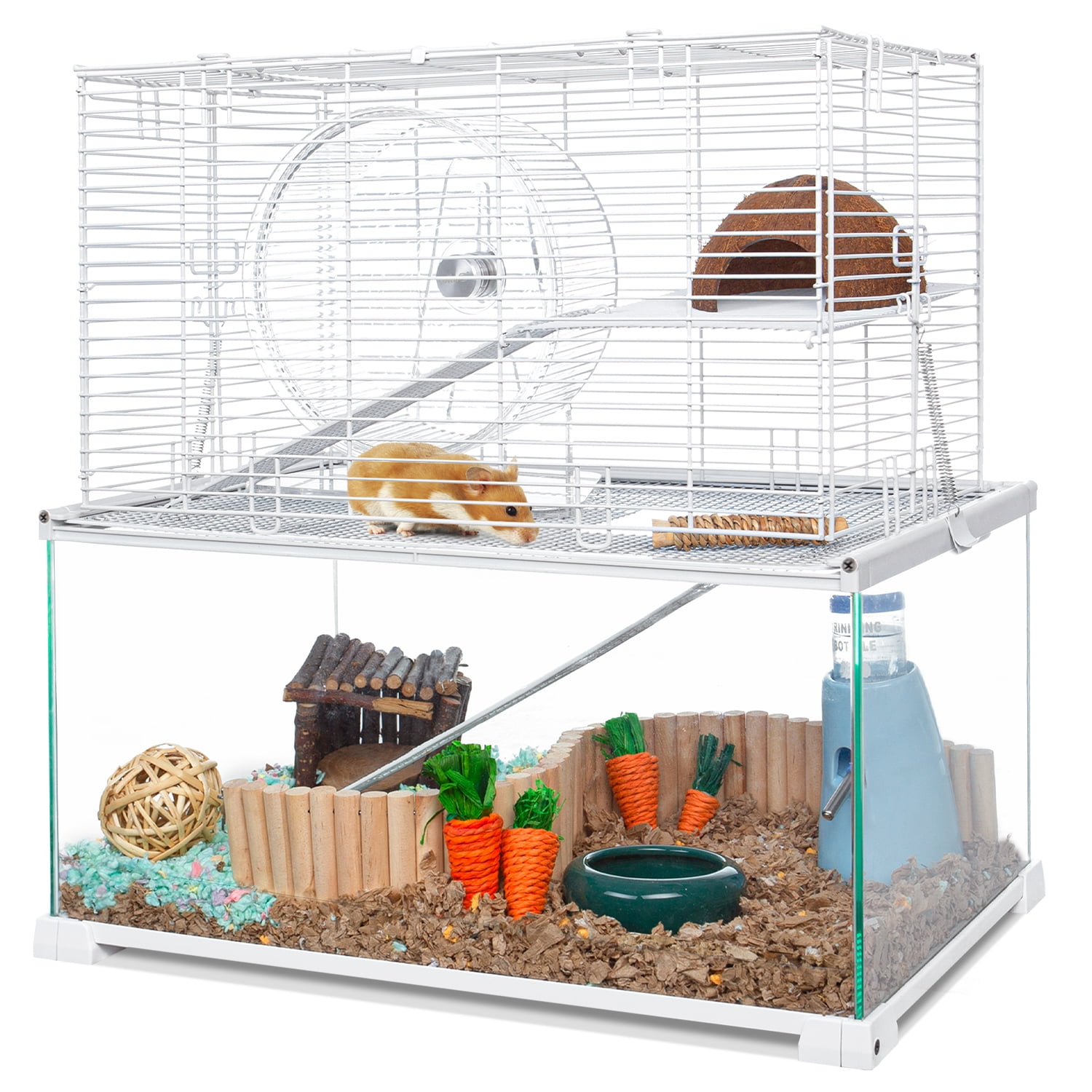Have you ever seen a hamster that is bigger than the palm of your hand? A hamster that could rival a house cat in size? These larger-than-life rodents, also known as big hamsters, are gaining popularity among pet owners. While the typical image of a hamster may be a small and fluffy creature running in its wheel, big hamsters offer a unique and intriguing experience for their human companions.
From their fascinating history to their unique characteristics and care requirements, big hamsters have captured the hearts of many. In this article, we will delve into the world of big hamsters – from their tiny beginnings to mighty breeds, bringing one home, enriching their lives, caring for them, understanding their behavior, and the pros and cons of having them as pets. So let’s get started!
>> READ MORE:
- The Ultimate Guide to Setting Up a 40-Gallon Tank for Your hamster
- Do Hamsters Get Rabies?
- The Naked Truth Why is My Hamster Losing Hair?
- Choosing the Best Hamster Food A Comprehensive Guide
Bringing Home a Big Hamster: Choosing the Right Breed and Setup

Before bringing home a big hamster, it’s essential to understand the different types of breeds and their specific needs. The term “big hamster” generally refers to Syrian hamsters and hybrid breeds created through selective breeding techniques. Let’s take a closer look at these breeds:
Syrian Hamsters
Also known as golden hamsters, Syrian hamsters (Mesocricetus auratus) are the most common hamster species kept as pets. They are native to Syria and parts of Turkey and are found in a range of colors, with their distinctive reddish-brown fur being the most popular. As adults, they can reach an average size of 5-7 inches in length and weigh 5-8 ounces.
Syrian hamsters are solitary creatures and should be kept alone to avoid potential fights and aggression. They are also nocturnal, so expect them to be most active at night. Due to their large size and solitary nature, they require a relatively spacious cage to roam and play in.
Hybrid Hamsters
The world of big hamster breeding is a fascinating one, with breeders creating hybrid breeds through selective breeding techniques. These hybrids are often larger than Syrian hamsters and come in a variety of colors and patterns. Some popular hybrid breeds include:
- Panda Bear Hamsters: These are a cross between Syrian and dwarf hamsters, resulting in a larger size and distinctive markings resembling a panda bear.
- Dalmatian Hamsters: As the name suggests, these hybrids have black spots on their white fur, similar to the coat pattern of Dalmatian dogs.
- Sapphire Winter White Hamsters: A cross between a Winter White Dwarf Hamster and a Campbell’s Russian Dwarf Hamster, this hybrid has a unique silver-blue coloration.
When bringing home a big hamster, it’s crucial to provide them with a suitable setup that meets their specific needs. Here are some essential factors to consider when setting up their home:
- Cage Size: As mentioned earlier, big hamsters require more space than their smaller counterparts. The minimum recommended cage size for a single Syrian hamster is 24 inches long, 12 inches wide, and 12 inches high. For hybrid breeds, a larger cage is recommended, at least 30 inches long and 18 inches wide. It’s always best to go bigger than the minimum size to ensure your hamster has enough room to exercise and explore.
- Cage Type: Wire cages with solid floors are ideal for big hamsters as they allow for good ventilation and easy cleaning. Avoid cages with wire mesh flooring as it can be uncomfortable and possibly cause foot injuries.
- Bedding: Big hamsters love to burrow and make nests, so providing them with a deep layer of bedding is essential. Suitable bedding options include aspen shavings, paper-based bedding, or a mix of both.
- Hideouts: Hamsters are prey animals and naturally seek shelter when they feel threatened. Providing them with hideouts in the form of tunnels, igloos, or boxes will help them feel safe and secure.
- Toys and Enrichment: Big hamsters are active and curious creatures and need plenty of toys and enrichment activities to keep them mentally stimulated. Toys such as chew sticks, tunnels, and running wheels are all great options for big hamsters.
- Location: It’s best to keep your big hamster‘s cage in a quiet and low-traffic area of your home. They are sensitive to loud noises and bright lights and can become stressed if their environment is too chaotic.
Enriching the Life of a Big Hamster: Exercise, Play, and Socialization

Big hamsters are intelligent and energetic creatures that require plenty of exercise and mental stimulation to thrive. Here are some tips on how to enrich their lives and keep them happy and healthy:
Provide Plenty of Exercise Opportunities
Big hamsters love to run, climb, and explore, so it’s essential to provide them with ample opportunities to do so. An appropriately sized and well-equipped wheel is a must for big hamsters. The wheel should have a solid surface and be at least 8-12 inches in diameter for Syrian hamsters and 10-14 inches for hybrids. Other exercise options include hamster balls or playpens where your pet can safely roam and explore.
Create an Engaging Environment
In addition to providing exercise equipment, it’s also important to create an engaging and stimulating environment for your big hamster. Consider adding different levels to their cage, such as platforms or ramps, to encourage climbing and exploration. You can also add tunnels, bridges, and other hiding spots for them to discover. Rotating their toys and hiding treats throughout their cage can also keep them entertained and prevent boredom.
Engage in Playtime with Your Hamster
Big hamsters are social creatures and enjoy spending time with their human companions. Set aside some time each day to interact and play with your pet. You can offer them treats, teach them simple tricks, or simply let them explore outside of their cage under your supervision. This will not only provide mental stimulation for your hamster but also strengthen the bond between you.
Feeding and Caring for a Big Hamster: A Complete Guide

Feeding a big hamster is similar to feeding any other hamster, but given their larger size, they may require more food and water. Here are some essential guidelines to ensure your big hamster‘s nutritional needs are met:
- Hamster Food: A good quality hamster mix should make up the bulk of your big hamster‘s diet. These mixes typically contain a variety of seeds, grains, and dried vegetables. Avoid mixes that contain high amounts of sunflower seeds as they are high in fat and can lead to obesity.
- Fresh Vegetables: In addition to their hamster mix, big hamsters can also enjoy small amounts of fresh fruits and vegetables. Some suitable options include carrots, broccoli, apples, and bananas. Be sure to wash all produce thoroughly before offering it to your hamster.
- Protein Sources: Big hamsters need protein in their diets to stay healthy, and this can be provided through high-quality hamster pellets or occasional treats such as mealworms or cooked chicken. Always give these in small amounts to avoid overfeeding.
- Clean Water: A constant supply of clean, fresh water is essential for any pet, and big hamsters are no exception. Consider using a water bottle attached to the side of their cage rather than a bowl to prevent spilling.
- Monitor Diet and Weight: It’s important to monitor your big hamster‘s diet and weight to ensure they are not becoming overweight. If you notice your hamster gaining too much weight, reduce the amount of food given or switch to a lower-fat food mix.
In addition to their dietary needs, big hamsters also require regular grooming to stay clean and healthy. This includes weekly nail trimming and occasional brushing to remove loose fur. As with any pet, it’s also important to keep their living space clean and hygienic to prevent illness and maintain their overall well-being.
Understanding Big Hamster Behavior: From Nesting to Chewing

Big hamsters may look intimidating due to their size, but they actually have many endearing and fascinating behaviors that make them great pets. Here are some common behaviors seen in big hamsters:
- Nesting: Hamsters are natural nest builders and will spend hours arranging their bedding and creating cozy spaces to sleep in. Offer them a variety of materials such as paper, hay, and tissues to help them build their nests.
- Chewing: Like all rodents, big hamsters have continuously growing teeth and need to gnaw on things regularly to keep them at a healthy length. Providing chew toys and wooden blocks can help satisfy this natural behavior.
- Hibernation: During the colder months, big hamsters may enter a state of hibernation known as torpor. This is a natural process for them, but it’s essential to monitor their temperature and wake them up if needed to ensure they do not enter true hibernation, which can be dangerous for them.
- Biting: While hamsters are generally docile creatures, they may bite if they feel threatened or are in pain. Always handle your big hamster gently and avoid sudden movements. If they do happen to bite, do not punish them as this can only make the behavior worse. Instead, try to understand why they are behaving this way and work on resolving the underlying issue.
Big Hamsters as Pets: The Pros and Cons

So now that we’ve covered the basics of caring for a big hamster, let’s take a look at some of the pros and cons of having one as a pet:
Pros
- Fascinating and Unique: Big hamsters offer an interesting and different experience compared to standard-sized hamsters. They are also relatively rare, making them a unique pet to have.
- Intelligent and Affectionate: Big hamsters are intelligent creatures that can form close bonds with their human companions. With proper socialization and care, they can become quite affectionate and interactive pets.
- Great for Families: Unlike some larger pets, big hamsters are low-maintenance and can be great for families with children. They are also less expensive to care for compared to larger animals like dogs or cats.
Cons
- Require More Space and Specialized Care: Due to their size, big hamsters require more space, especially in terms of cage size, and have specific needs that need to be met. This can make them a bit more challenging to care for compared to smaller hamsters.
- Short Lifespan: Unfortunately, big hamsters have a relatively short lifespan of 2-3 years, so their time with you may be limited compared to other pets.
- Expensive: While big hamsters themselves may not be expensive to purchase, their specialized care and equipment can add up, especially if you opt for a hybrid breed.
Conclusion
In conclusion, the allure of the big hamster goes far beyond their size. These fascinating creatures offer a unique and rewarding experience for those willing to take on the challenge of caring for them. From choosing the right breed and setup to enriching their lives and understanding their behavior, big hamsters have much to offer as pets. So if you’re looking for something a little bigger and more exciting than a traditional hamster, a big hamster may be just the pet for you.

